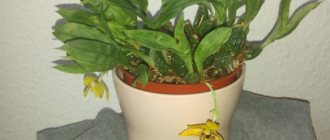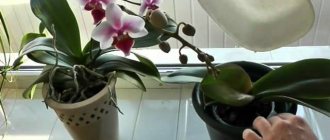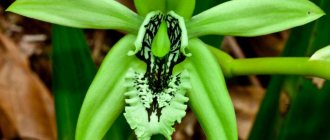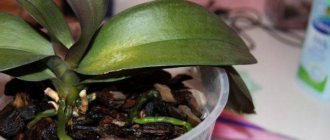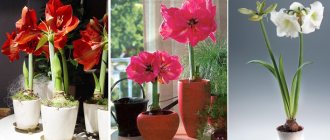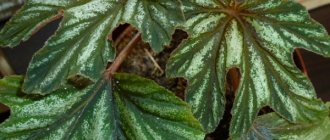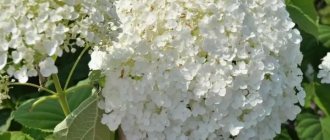What does it look like?
The arrow looks like a long stem (in favorable conditions it can reach a length of 80 - 100 cm) of green color, cone-shaped, without flowers, which most often grows above the place of previous flowering. The arrow is not smooth, but has irregularities - places where plant buds form: dormant and flowering. From the flowers, buds and orchid flowers are formed, and from the dormant ones, a side arrow or a baby may appear.
The peduncle does not always grow upward; sometimes it can grow to the side or down. It can also bend in a weird way, for example, in the shape of a pig's tail.
orchid peduncle
The peduncle is the part of the plant on which buds will form and, when they bloom, delight the grower.
The peduncle plays an important role in the life of an orchid.
If a flower shoot appears on the plant, then this condition can be called the active phase of plant development. At this moment, the plant must be fed with fertilizers intended for orchids. A photo of how orchids produce flower stalks can be seen above.
IMPORTANT! All fertilizers are applied only after watering, so that the velamen on the orchid’s root system does not burn.
Description
At the moment of appearance, the peduncle can be confused with other parts of the plant. A novice gardener wonders what appeared on his plant :
- Peduncle;
- Root;
- Or baby?
The peduncle begins to grow from the axil of the leaf blade . You also need to carefully examine the tip of the growing bud:
- The flower shoot will have a pointed end;
- And the roots and children are the blunter end.
And the most important thing is that the frog has a scaly coating , and the velamen on the roots has a smooth structure.
Where might it come from?
How does the peduncle of an orchid grow? We must remember that the peduncle develops from the axil of the plant leaf. Sometimes it comes out from the growth point.
All other shoots emerging from the stem and other parts (root areas) can be roots or children.
A peduncle can also appear when it blooms again from a waiting bud of an old flower shoot. It grows to the side of the main stem and does not develop many buds.
The peduncle appears from the axil of the orchid.
Sometimes the peduncle develops at a rapid pace, this indicates that the care is organized correctly . But it happens that escape:
- At first it slows down development;
- And then it completely begins to turn yellow and dry out.
This indicates that the flower is receiving little light and nutrients. On average, the development of a peduncle can take up to 3 months.
IMPORTANT! With sufficient lighting, watering and fertilizing, the shoot will form at the required pace, and the flowers blooming on it will reach their maximum size.
Favorable time for the growth of new shoots
Many beginners ask questions: when will the orchid release a peduncle and how long does it take for a new peduncle to grow?
All orchid plants begin to bloom at different times relative to their age. You cannot demand the appearance of a peduncle from a young rosette.
There are plants that bloom in the third year of life, and there are those whose age should be older.
How long does the flower stalk take to grow? It depends on the type. Some bloom all year round, regardless of the changing seasons.
Others only at certain times :
- Phalaenopsis blooms all year round with proper care;
- Cymbidium - from mid-autumn to the end of February;
- Dendrobium blooms from October to early January.
But also do not forget that everything depends on the cultivation of the orchid itself :
- If you didn't water on time, the flowers may dry out, and with them the flower shoot.
- In the absence of useful nutrients, the escape will be short.
- Also, for the development of the arrow, high humidity and good diffused sunlight are necessary.
- When buds appear, the fertilizing is removed completely , as this can greatly shorten the flowering period of the orchid.
Photo
Next you can see the photos showing the arrow of the orchid:
Why doesn't an orchid bloom for a long time? Why doesn’t an orchid bloom at home and what to do about it?
Growing orchids is inextricably linked with the anxious anticipation of their flowering. During this period, plants become unusually spectacular, revealing their exotic beauty to the fullest. However, it often happens that for one reason or another, capricious tropical flowers do not bloom. Sometimes the duration of “flower silence” is calculated in years. For what reasons may orchids not bloom at home, what needs to be done to correct the situation?
Why doesn't the orchid bloom?
Flowering time, its frequency and duration depend on the characteristics of the plant variety. Most varieties begin to form the first buds at the age of 1.5-3 years. To determine the age of an exotic plant, it is necessary to count the number of shoots in its rosette - for example, two-year-old plants have at least 5 of them. Orchids usually bloom once every 2-3 months. Proper care and care of the plant ensures its flowering 2-3 times a year. Experienced plant growers claim that if an exotic plant does not form flowers for more than a year, then this clearly indicates the presence of some kind of problem.
At the same time, plants that stubbornly do not bloom can feel quite at ease. They produce new leaves, roots grow, and even flower stalks form. However, the formation of buds on peduncles does not occur. It even happens that an orchid can release a peduncle, which dies very quickly. The main factors due to which orchids do not form buds and bloom are:
- natural causes;
- improper care.
How is it different from other parts of the plant?
Often, novice flower growers cannot determine what the orchid has produced: a root or an arrow . Indeed, only a florist with many years of experience can accurately identify the part of a plant, especially at first. But after some time, when the process reaches 1 cm in length, this will not be difficult to do.
The main difference is that the tip of the peduncle is sharp and the same color as the shoot, and the root is rounded and pinkish in color. Another part of the plant, which is also often confused with the arrow, can be distinguished by its shape - the root shoot. It has the shape of a boat.
Immediately after its appearance, the root begins to look down (stretches towards the soil and nutrients in it), and the arrow begins to look up (stretches towards the light), just like the root baby. The root is smooth, and the arrow contains "scales". The root most often grows from the neck of the plant trunk, the shoot - between the leaf plates.
We invite you to watch a video on how to distinguish the peduncle from other parts of the orchid:
What it is?
Definition
Peduncle is a shoot that arises between the rosettes of leaves. The new shoot, from the very beginning, has the rudiments of buds that look like scales. Over time, the new growth with buds will develop into a strong stem with several dozen buds. It tends upward and resembles a spike in the arrangement of flowers on it.
What it looks like: description and photo
The peduncle is a stalk that is rough to the touch, with small mounds (at the site of bud formation), and sharp at the end. It arises either from the axils of the leaves, or on an old, trimmed, faded stem, from a waiting bud. In this case, the shoot grows sideways and will not have such abundant flowering as a fresh peduncle.
How to distinguish from the root and other parts?
Inexperienced breeders often confuse the peduncle with fresh roots or babies. An orchid is an epiphyte that has aerial roots that resemble small green worms in diameter, which is why they are so easy to confuse with a peduncle. The spine is smooth and rounded at the end, which distinguishes it from the arrow. The baby, when formed, changes shape and becomes like a boat and emerges from the root zone, and not from the leaf sinus.
Role in the life of a plant
The arrow of an orchid performs a reproductive function. It most often produces babies - small copies of the orchid itself. After they produce a couple of leaves and 3-4 roots, they can be rooted.
In addition, the peduncle is involved in the appearance and development of flowers and buds , nourishes them with water and nutrients, thereby continuing to perform a reproductive function. Each orchid flower contains a seed capsule in which the seeds ripen after pollination by insects. An orchid can also be grown from seeds, but this can happen either in a natural environment - the tropics, or in laboratories, since this process is long and intricate.
Role
The arrow of an orchid is also called the peduncle. It performs the function of reproduction. This happens in two ways:
- Flower buds form on the shoot, which turn into buds . If the flower is pollinated, it forms a seed capsule containing up to 5 million seeds. They are tiny yellow dust.
- In addition to flower buds, dormant buds appear on the arrow . Of these, after flowering, a side shoot or baby appears. The newborn orchid subsequently grows roots and becomes an independent plant.
How did the flower shoot?
After the period of active growth of roots and leaves, the orchid enters a resting phase, during which the plant shoots out an arrow. Most often this period occurs in autumn, but in good conditions the orchid can bloom several times a year.
An orchid shoot is released from the axil of a leaf , usually the lowest one. The leaf axil is the place where the orchid leaf comes into contact with its trunk. The arrow breaks through the sheet and tends upward. The appearance of the arrow occurs under the influence of many factors: lighting, temperature, watering. If favorable conditions are not created for the orchid, then the formation and release of a peduncle will be impossible.
Formation period
How quickly does it form?
Let's consider how long the peduncle of an indoor phalaenopsis orchid grows. The average time for its formation in a regular phalaenopsis is two months, in a hybrid one – three. This is exactly how much time must pass after the appearance of the stem before the peduncle is fully formed. If the plant is in comfortable temperature conditions and receives the required amount of light and moisture, then this time will decrease by 1.5-2 times.
The lateral peduncle develops faster - in about 1.5 months.
How many arrows does it fire?
The most common type is phalaenopsis, which has 2-3 peduncles, but there are also specimens with a large number of peduncles. At home, the number of arrows depends on the type of phalaenopsis, its health and the care provided.
The number of buds in an orchid increases under extreme conditions, for example due to temperature changes, drought or an unusually large amount of light.
How to ensure growth?
How to grow a flower stalk? In order to grow it, you first need to make sure that the new growth on the phalaenopsis is actually an arrow. If this is the case, then you need to wait until it reaches a length of 15-20 cm and fix it in a vertical position, tying it to a support in a flowerpot.
It is best to use a special clothespin for this, which can be purchased at any flower shop, but you can also use a regular hair elastic or a small hair clip. If you can’t tie the peduncle to the support, you just need to rotate the pot with the orchid relative to the light.
What to do during this process?
- Place the container with the flower in a well-lit place. Windows facing south, southeast and southwest are suitable for this.
- If daylight hours last less than 12 hours, then the orchid must be placed under an additional light source (fluorescent lamp, phytolamp).
- Provide systematic moderate watering with settled or boiled water at room temperature.
- Continue to feed the plant if this was done before the arrow was released.
As a top dressing, ready-made mineral fertilizers for orchids containing phosphorus and potassium are usually used. They are sold in specialized stores. If fertilizing has not been done before, then you should not start with the release of the arrow - the orchid may “freeze”.
We invite you to watch a video containing recommendations for caring for orchids that have released a peduncle:
What to do after flowering?
After the phalaenopsis has bloomed, the peduncle has the following development options:
it turns yellow and dries out - in this case, you need to cut it off at the very base, and sprinkle the resulting cut (stump) with chalk, cinnamon powder or wood ash for disinfection;- Only the apical bud dries out; it is better to cut the branch with it to the first lower bud;
- it remains intact, with a green tip and dormant buds, that is, it may well produce new flowers in the near (or not so soon) time. In this case, you don’t need to do anything with the peduncle.
Read more about how to care for an orchid after flowering in a separate article.
Let's watch the video of how to trim a dried peduncle.
What to do if you can't escape?
- Arrange a temperature difference . The difference between the thermometer readings at night and during the day should be 5C – 7C. A similar difference can be achieved by placing the orchid pot on a heated balcony or terrace.
- Provide enough light for the plant. The required daylight hours are 10–12 hours. In the cold season (autumn, winter), the flower must be illuminated with a phytolamp.
- Ensure proper watering . The orchid requires moderate, systematic watering before flowering and when the arrow appears. But it is important to remember the main principle: do not flood the roots! It is necessary to constantly monitor the condition of the root system and substrate.
Monitor the humidity level in the room where the orchid is located. To release the arrow, the optimal humidity should be 30% - 40%.- Provide the plant with fertilizers based on potassium and phosphorus: they have a beneficial effect on the formation of flower buds.
- Scare . If the above points have been completed, but the orchid has not released an arrow, then it is recommended to arrange a stressful situation for it: reduce watering to a minimum and move the pot to a cooler place.
Some florists use special chemicals to stimulate orchids to bloom. "Epin" is very popular. They should spray the plant daily in the morning.
You can also water the plant by adding 3 to 5 drops of the drug to the water (details in the instructions).
Cytokinin paste is used as a phytoharmone, and succinic acid is used as a growth regulator and anti-stress drug (dissolve 2 g in 1 liter of water).
We suggest watching a video about why an orchid does not produce a peduncle and what to do in this case:
Features of care during the growth period
The period of peduncle growth is a very important moment in the life of an orchid, when it is especially important to provide it with good care.
- It is necessary to provide the plant with good lighting. Daylight hours for a phalaenopsis that has released a shoot should be at least 12 hours. In autumn and winter, you need to place a pot with an orchid on the window sill on the south side of the room, and if this is not possible, you should use a phytolamp for additional lighting.
- Humidity needs to be maintained at an optimal level; for this you can use a humidifier or place a container of water next to the orchid. This is especially important in winter when the indoor air is too dry.
- It is imperative to feed the plant with fertilizers that contain a lot of phosphorus and potassium from the moment the peduncle has just begun to form until the flowers appear on it. After the flowers appear, fertilizing should be suspended, as this will not increase the splendor of flowering, but may provoke a drop of flowers.
- Watering is carried out as usual - as the soil dries out. The regularity is individual for each specific case, as it depends on the temperature and humidity of the air. Phalaenopsis with a regrown peduncle does not need direct spraying; it will most likely destroy the sprout. It is enough to place a flowerpot with an orchid between other plants while spraying them and it will have enough moisture.
Important! Under no circumstances should the soil in the flowerpot be allowed to become completely dry.
Video about caring for phalaenopsis during the period of peduncle growth:
The new arrow broke
- Do not leave a broken arrow on the plant, do not glue it with tape, adhesive tape, or bandage it.
- Cut with sharp and sterile scissors 1–2 cm above the dormant bud. There is a high probability that a lateral peduncle will form from the dormant bud.
- If the peduncle breaks at the root, then you need to cut it off completely, trying to leave a small stump 1-2 cm high.
- Sprinkle the cut area with cinnamon or crushed activated carbon.
- A broken arrow can be placed in water, changing it periodically. An orchid can begin to bloom this way.
To prevent such cases from reoccurring, it is necessary to provide the plant with a habitat in which the likelihood of causing mechanical damage to the flower will be reduced to zero. Since plastic pots are quite unstable, it is advisable to place them in pots that are more stable: glass or ceramic.
Possible problems and their solutions
It happens that the peduncle either grows somehow “wrongly” or is completely absent.
Unfortunately, injury to the plant is also possible when the arrow breaks. For beginners, such emergency situations cause a lot of anxiety.
There's no need to panic. Let's look at each of these cases and consider what the gardener should do.
Emergence from the growth point
The arrow grows from the growth point - this happens with older phalaenopsis that have survived many flowering cycles. Another reason is severe stress experienced by the plant. This is the same case when the owner of the plant does not need to do anything. Just take care of your pet as usual. Perhaps the arrow will still produce buds or a baby.
The flowering shoot is broken
What to do? Simply cut the peduncle to the bud closest to the fracture site, and treat the cut area with activated carbon or cinnamon powder. Under no circumstances try to connect the fragments with tape or tape, as some inexperienced amateurs try to do, in the hope that their orchid will “grow together.” This will only harm the plant; it may begin to dry out!
Absent at all
What should the owner of a “lazy” phalaenopsis do, how can he still grow a peduncle? If the plant is in no hurry to shoot out its arrows, you can give it a little shake-up - place it in a darker place than usual and water it less often than before (of course, without leading to complete drought). If possible, it is better to lower the temperature for phalaenopsis at night by 5-6 degrees . Experienced gardeners make plants that have been dormant for even a year or more bloom in this way.
Stuck in development
It happens that the peduncle grows to a sufficient length and even produces several buds, and then suddenly stops its growth.
If phalaenopsis stops growing, algorithm of actions:
- First of all, you should make sure that the orchid is healthy. Perhaps the reason is some kind of disease or pest.
- Analyze the conditions of keeping your phalaenopsis - does it have enough light, is the humidity and temperature regime observed, does it have enough feeding?
- If, after treatment and the establishment of optimal conditions, the peduncle continues to remain frozen, the most reasonable thing is to take a wait-and-see approach and watch the arrow. If it hasn’t dried out, there is a chance that your green friend will someday please you with flowers.
You can learn more about the main reasons for the lack of flowering of phalaenopsis here, and from this article you will learn how to make an orchid bloom at home.
Possible problems
It often happens that the arrow is released, but does not develop further, but seems to freeze in place. Or another option is possible: the peduncle has grown, but has begun to dry out. The reasons for such phenomena are directly related to the fulfillment of the basic requirements for the maintenance of an orchid.
Among them:
- improper lighting;
- excess or lack of fertilizers;
- problems with the root system;
- over- or under-watering;
- infectious diseases and pests;
- incorrect temperature.
Phalaenopsis orchid does not bloom, what to do? Analysis of orchid keeping conditions
When buying a flower, you need to ask a specialist for an explanation of what variety it is and the characteristics of its cultivation. Phalaenopsis orchid, the most unpretentious variety that tolerates light shading. But there are orchids for which a south window is suitable, and even summer heat is tolerated well by them. An orchid does not bloom if the conditions of its maintenance are violated.
You should always place a saucer of boiled water next to the orchid. Place a clove of garlic in the substrate.
If the flower was purchased in a store, and it was already blooming, and the arrow turned yellow, then the rest period can last up to a year. If the plant is grown from children, then it will take more than two years to wait for the first flowering. By this time, the root system will gain strength and the orchid will produce 5-6 leaves. Early flowering will weaken the beauty.
Why doesn’t an orchid bloom at home after transplantation? When should we expect the first arrow? The transplanted plant initially builds up its root mass within six months. Afterwards, aerial roots develop and leaves grow. Flower buds are formed in the axils. The initial period of plant development in favorable conditions contributes to the laying of a larger number of flower stalks.
Let us remind you how to properly maintain an orchid:
- The roots are well developed, green, some of them are located on the walls of the transparent pot, some are at the top, absorbing moisture from the air.
- The substrate does not contain fresh bark, sawdust or manure.
- It is better to keep the lighting diffused.
- The difference in day and night temperatures when planting flower stalks should be at least 5 degrees.
- Fertilizing with liquid fertilizers depleted in nitrogen once every 10 days before the arrow shoots.
The conditions for laying flower buds are listed, but biological requirements for the maintenance of orchids must be observed.
What to do if the orchid does not bloom or develop well? It will be necessary to provoke the release of the arrow. The aerial root and the arrow look the same at first. But the tip of the arrow is rounded, and at the root it is sharp, as in the photo.
How to care?
In order for an orchid to send out its arrow and enjoy its flowering for a long time, you need to provide it with comfortable living conditions. To do this you should:
- Maintain the room temperature in summer: +22-25ºС, in winter +16-18ºС.
- Place the pot in the sun, but not under scorching rays. In summer, it is recommended to shade the window.
- Maintain humidity during the growing season within 50-60% with a household humidifier, and for releasing a peduncle - 30% - 40%.
- Ventilate the room regularly.
- Water once a week; in between, the soil should dry out completely. To release the peduncle, the “dry” period can be extended.
- Use warm and purified water.
- Fertilize orchids with fertilizers containing potassium and phosphorus.
From our other publications you will learn what role the pseudobulb plays in the life of a plant, what a growing point is and why the roots of a plant grow upward.
The moment the orchid's arrow appears, real joy comes to the gardener. But it is important to remember that the key to the future successful flowering of a plant is compliance with the basic requirements for the conditions of keeping the epiphyte, especially at the moment when the plant is most vulnerable.
Caring for the plant before and after the appearance of the arrow
Cultivation of a flower until a shoot appears in the standard way :
- Lighting must be absent-minded. We must remember that already in April the flower is removed from the windowsill in the southern direction;
In order for a healthy peduncle to grow, it is necessary to create suitable conditions. - Watering is organized in such a way that between waterings the bark dries out for a couple of days, which will allow the root system to participate in photosynthesis;
- There must be access to fresh air and, at the same time, no draft. This is especially destructive in the cold season, since frostbite cannot be treated, the damaged parts are simply cut out;
- Humidity should be at 65-85%;
- Fertilizing is carried out with specialized fertilizers, which are marked “For orchid plants”. Others may burn the root mass and require a long resuscitation of the plant.
When a flower shoot appears, the conditions change slightly and you need to pay attention to the parameters described below for caring for the orchid.
Reducing the watering schedule
Watering begins to be reduced as soon as the arrow begins to develop. But this does not mean that the flower should be overdried.
When a flower stalk appears, it is necessary to reduce watering.
We just leave between waterings not 2-3 days of drying, but 5. That is, if watering was once a week, now it is watered once every 2 weeks.
Features of fertilizing
When a flower shoot appears, fertilizing is slightly reduced . And when the buds begin to form, they stop altogether. Because fertilizing greatly shortens the flowering period.
Lighting and temperature
If the arrow began to form in the autumn-winter period, the flower is placed on a windowsill in a southern direction . If it is not there, then you need to take care of additional lighting, since without sufficient lighting the shoot will not develop.
The air temperature in the room for proper development should be between 23-26 degrees Celsius . Cold weather may well slow down development and, if measures are not taken, the shoot will begin to dry out.
IMPORTANT! Having familiarized yourself with the basic requirements for forming a flower arrow, you must adhere to them. And we must remember that the quantity and quality of buds is influenced by caring for the plant in the previous four months, and not by applying fertilizing at the last moment while the shoot is growing.
Why doesn't the orchid bloom, but only leaves and roots grow?
To establish the reason for the lack of flowering, you need to know the basic rules of care and external signs of a healthy orchid.
State of the root system
The development of the root system is closely related to the state of the above-ground part of the orchid. No matter how many aerial roots a plant has, it is important that they look healthy. By the appearance of the roots you can judge what the plant lacks:
- darkening of the roots is a sign of waterlogging and rotting;
- the appearance of a large number of aerial roots – increased dryness in the room.
Normally, the growing root tips are bright light green in color. If they are not visible for several months, it is necessary to reconsider the care of the plant.
Healthy root system.
Substrate composition
Fresh bark, sawdust or manure does not contribute to the emergence of a peduncle. Unlike other indoor plants, orchid roots are not able to absorb nutrients from the soil, so they need a specially selected substrate.
Important! An incorrectly selected mixture will cause waterlogging and rotting of the roots, in which case the plant will not bloom.
The composition of the substrate for orchids usually includes:
- pieces of pine bark;
- inert material (foam balls, expanded clay);
- sphagnum moss.
Substrate for orchids.
Sometimes other components are added to it. The following should be taken into account:
- fresh bark can be a source of infection, causing the plant to become sick. Before use, pieces of bark are boiled for 1 hour in order to get rid of pests and microorganisms, as well as resin residues;
- sawdust cannot be added to the substrate, as it consists of very small particles, which stick together when watered and disrupt the aeration of the roots;
- manure contains too many mineral and organic substances that are harmful to orchid roots.
A properly selected substrate is the key to the health and regular flowering of an orchid.
Lighting
Light is one of the main conditions for the good development and flowering of an orchid. If the lighting is chosen incorrectly, this will affect the condition of the plant:
- the leaves stretch out and become lighter;
- growth slows down and flowering stops;
- a peduncle does not form;
- Direct sunlight in summer causes burns on the leaves.
Even unwrapping the pot or moving it to another location can cause stress, resulting in a lack of flowering.
For regular orchid flowering you need:
- a large amount of diffused light;
- in the autumn-winter period, daylight hours are extended to 12 hours using a special phytolamp.
Insufficient duration of lighting in winter is the main factor due to which an indoor orchid does not form a peduncle.
Daily temperature difference, optimal temperature day and night
In nature, orchids grow in tropical forests, so in indoor culture, moist and warm cultivation conditions are most suitable for them:
- in summer, the optimal temperature in the apartment is 15-30℃, in winter – 20-23℃;
- The formation of a peduncle is stimulated by daily fluctuations in day and night temperatures within 5-7℃, which allows the plant to safely turn on the flowering mechanism.
In summer, such a natural temperature difference is created when growing an orchid on the balcony.
In summer it is recommended to grow orchids on the balcony.
Top dressing
Lack of flowering may be a consequence of improper feeding with an unbalanced fertilizer composition.
Attention! If there is good growth of the roots and leaves of an orchid, but the plant does not bloom, the most likely reason is the increased nitrogen content in the fertilizer.
Conventional phosphorus-potassium fertilizers are not suitable for feeding this plant. It is better to use special fertilizers for orchids with a low nitrogen content:
- fertilizing is applied only during the period of vegetative growth;
- Before fertilizing, water the plant so that the fertilizer does not cause burns to the roots;
- in the winter months, as well as in summer at temperatures above 24℃, fertilizing is applied once a month, in spring and autumn - once every two weeks.
- A plant that is in the leaf and root growth stage has a greater need for nitrogen.
- When forming flower-bearing arrows - in phosphorus and potassium.
The orchid does not bloom. Why don't orchids bloom?
Many amateur flower growers do not understand why their orchid has not bloomed for a year or 2 years. Let's take a closer look at the main question: why don't orchids bloom and what to do at home if a problem arises?
Care errors
The duration and frequency of flowering of an orchid depends both on the conditions of its maintenance and on its belonging to a particular species or variety.
If not properly cared for, the orchid will not bloom.
Hybrid varieties adapted for growing at home are characterized by cyclical flowering up to 2-3 times a year with breaks for rest. Violation of this rhythm indicates mistakes made when caring for the plant, resulting in non-flowering orchids.
Temperature violations
The homeland of orchids is humid and warm tropical forests, so when kept indoors it is necessary to maintain the correct temperature regime:
- At temperatures above 25-30℃, plants intensively grow green mass and bloom poorly; in winter, the temperature should not fall below 16℃. The optimum temperature for an orchid is 20-24℃;
- The formation of peduncles is well influenced by daily fluctuations in day and night temperatures within the range of 5-7℃.
This corresponds to the natural life cycle of the plant, during which a safe flowering mechanism is launched.
Lighting nuances
One of the main factors that affects the development and flowering of an orchid is light. Incorrect lighting causes stress:
- The leaves stretch out, their color becomes lighter;
- Growth slows down and flowering stops;
- A peduncle does not form;
- Direct sunlight in summer causes burns on the leaves.
The plant is sensitive even to such nuances of lighting as turning the pot around or moving it to another place, which can cause the flowers to drop.
Irrigation technique
Novice gardeners sometimes get too carried away with watering, which results in problems for the orchid:
- Frequent watering stimulates the development of vegetative parts: roots and leaves;
- Excessive moisture can cause roots to rot, causing them to become dark in color. This plant will not bloom.
The watering regime must be adjusted, and if rotten roots are found, the plant is transplanted into new soil.
Incorrect composition of fertilizing
An incorrectly selected fertilizer composition can be a factor due to which an orchid does not form a peduncle, for example, a variety such as cymbidium:
- Excess nitrogen stimulates the growth of the root system and leaves;
- Phosphorus in fertilizers stimulates the formation of peduncles.
Important ! For feeding, you need to use only special fertilizers for orchids with a low nitrogen content.
Before feeding orchids, make sure that the fertilizer contains the correct composition.
Above you can see a photo of what fertilizers for orchids at home from Bona Forte look like. The optimal ratio of nitrogen, potassium and phosphorus to stimulate flowering is 2:6:6.
After transplant
The roots of the plant are very sensitive to transplantation and take a long time to recover after it. The lack of flowering during this period may be due to the fact that:
- During the first half of the year after transplantation, the root mass actively grows. Then aerial roots form and leaves grow, in the axils of which flower buds are laid;
- If too many roots had to be removed during replanting, the flower may not adhere well to the substrate, which will make flowering difficult;
- Incorrect plant maintenance and growing conditions have a particular impact.
Comfortable conditions created after transplanting an orchid determine good growth, development and early flowering.
Violation of the root system
If the plant is transplanted incorrectly, damage to the root system is possible:
- Root rotting due to improperly selected substrate;
- The volume of the pot is too small for the root system;
- Injury to roots during transplantation due to their ingrowth into the walls of the pot.
If the transplant was carried out correctly, but flowering does not occur, a possible reason may be improper care of the orchid.
The soil does not support the plant
If an orchid is poorly anchored in the soil for a long time, this may affect its ability to form a peduncle. In this case, the plant must be transplanted into a suitable substrate or soil must be added to the pot.
Healthy
Sometimes an apparently healthy plant has problems with flowering: either the orchid does not bloom or quickly fades.
Fattens and does not produce a peduncle
The reasons for non-flowering can be different:
- Monotonous watering of the plant has a positive effect on leaf growth;
- Nitrogen predominates in fertilizing, and the orchid quickly increases its leaf mass.
Adjusting the watering and nutrition regime will help restore flowering.
Gives only children
Most likely, the temperature regime is not observed: during the day +22-24 degrees, at night +16-18 degrees. An excess of nitrogen in fertilizing is also possible.
If feeding is poor, the orchid does not bloom, but only produces babies.
Has released an arrow, but does not bloom
The orchid shoots, but the flower does not bloom for a long time. This is often due to uncomfortable growing conditions:
- If the peduncle appears in the dark season without additional lighting, the plant will not have the strength to flower normally;
- Low air humidity or close proximity of heating devices causes drying of the flower stalk.
With proper care and following the recommendations, the orchid will feel great at home and delight you with lush flowering.
The influence of diseases and pests on the development of peduncles
A plant affected by a fungal disease or insects (aphids, soft-bodied mites, scale insects, etc.) has stopped blooming, what to do in this case?
Attention! The main cause of orchid disease is weak immunity, a consequence of improper maintenance and care.
Treatment involves the use of fungicides or insecticides. After the recovery period, the plant will bloom again.
Drops flowers and buds
The reasons why an orchid sheds flowers and buds include:
- Old substrate that has already decomposed and rotted;
- Rearrangement to another location during flowering;
- A nearby air conditioner or cold draft;
- During flowering, the air temperature rose above 30℃;
- A flowering plant is not fertilized;
- You can only spray the leaves, not the flowers.
With proper care, the orchid will delight you with flowering for many years.
